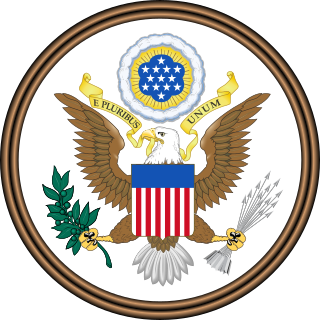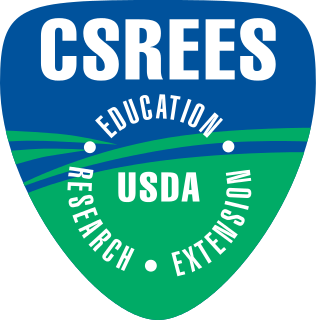Related Research Articles

The Morrill Land-Grant Acts are United States statutes that allowed for the creation of land-grant colleges in U.S. states using the proceeds of federal land sales. The Morrill Act of 1862 was enacted during the American Civil War and the Morrill Act of 1890 expanded this model.

The United States Department of Agriculture (USDA), also known as the Agriculture Department, is the U.S. federal executive department responsible for developing and executing federal laws related to farming, forestry, and food. It aims to meet the needs of farmers and ranchers, promote agricultural trade and production, work to assure food safety, protect natural resources, foster rural communities and end hunger in the United States and internationally.

The Smith–Lever Act of 1914 is a United States federal law that established a system of cooperative extension services, connected to the land-grant universities, in order to inform people about current developments in agriculture, home economics, public policy/government, leadership, 4-H, economic development, coastal issues, and many other related subjects. It helped farmers learn new agricultural techniques by the introduction of home instruction.
United States v. Butler, 297 U.S. 1 (1936), was a U.S. Supreme Court case in which the Court held that the U.S. Congress's power to lay taxes is not limited only to the level necessary to carry out its other powers enumerated in Article I of the U.S. Constitution, but is a broad authority to tax and spend for the "general welfare" of the United States. The decision itself concerned whether the processing taxes instituted under the 1933 Agricultural Adjustment Act were constitutional.

Oklahoma State University is a public land-grant and sun-grant research university in Stillwater, Oklahoma. OSU was founded in 1890 under the Morrill Act. Originally known as Oklahoma Agricultural and Mechanical College, it is the flagship institution of the Oklahoma State University System. Official enrollment for the fall 2010 semester system-wide was 35,073, with 23,459 students enrolled at OSU-Stillwater. Enrollment shows the Freshman class of 2012 was the largest on record with 4,298 students. OSU is classified by the Carnegie Foundation as a research university with highest research activity.

A land-grant university is an institution of higher education in the United States designated by a state to receive the benefits of the Morrill Acts of 1862 and 1890.
The Fair Deal was an ambitious set of proposals put forward by U.S. President Harry S. Truman to Congress in his January 1949 State of the Union address. More generally the term characterizes the entire domestic agenda of the Truman administration, from 1945 to 1953. It offered new proposals to continue New Deal liberalism, but with the Conservative Coalition controlling Congress, only a few of its major initiatives became law and then only if they had considerable GOP support. As Richard Neustadt concludes, the most important proposals were aid to education, universal health insurance, the Fair Employment Practices Commission, and repeal of the Taft–Hartley Act. They were all debated at length, then voted down. Nevertheless, enough smaller and less controversial items passed that liberals could claim some success.

The Federal Highway Administration (FHWA) is a division of the United States Department of Transportation that specializes in highway transportation. The agency's major activities are grouped into two programs, the Federal-aid Highway Program and the Federal Lands Highway Program. Its role had previously been performed by the Office of Road Inquiry, Office of Public Roads and the Bureau of Public Roads.
A Pell Grant is a subsidy the U.S. federal government provides for students who need it to pay for college. Federal Pell Grants are limited to students with financial need, who have not earned their first bachelor's degree, or who are enrolled in certain post-baccalaureate programs, through participating institutions. The Pell Grant is named after Democratic U.S. Senator Claiborne Pell of Rhode Island, and was originally known as the Basic Educational Opportunity Grant. A Pell Grant is generally considered the foundation of a student's financial aid package, to which other forms of aid are added. The Federal Pell Grant program is administered by the United States Department of Education, which determines the student's financial need and through it, the student's Pell eligibility. The U.S. Department of Education uses a standard formula to evaluate financial information reported on the Free Application for Federal Student Aid (FAFSA) for determining the student's expected family contribution (EFC).

The Higher Education Act of 1965 (HEA) was legislation signed into United States law on November 8, 1965, as part of President Lyndon Johnson's Great Society domestic agenda. Johnson chose Texas State University, his alma mater, as the signing site. The law was intended "to strengthen the educational resources of our colleges and universities and to provide financial assistance for students in postsecondary and higher education". It increased federal money given to universities, created scholarships, gave low-interest loans for students, and established a National Teachers Corps. The "financial assistance for students" is covered in Title IV of the HEA.

The Institute of Food and Agricultural Sciences (IFAS) is an agriculture, life science, pathogen, and invasive species research facility in Florida affiliated with University of Florida. It is a partnership between federal, state, and county governments that includes an extension office in each of Florida's 67 counties, 13 research and education centers, several demonstration sites, the University of Florida College of Agricultural and Life Sciences, the Center for Tropical Agriculture, portions of the University of Florida College of Veterinary Medicine, the Florida Sea Grant program, and the International Program for Food, Agriculture and Natural Resources.
Edwin Willits was a politician from the U.S. state of Michigan. Willits served as prosecuting attorney of Monroe County, Republican from Michigan's 2nd congressional district for the 45th, 46th, and 47th Congresses. Presidents of Michigan State Normal School and the State Agricultural College. The first Assistant U.S. Secretary of Agriculture under Jeremiah McLain Rusk for Benjamin Harrison's administration.
A common perception is that the birth of Cooperative Extension followed passage of the Smith-Lever Act of 1914, which provided federal funds to land-grant universities to support Extension work. In a formal sense, this is true. Even so, the roots of Cooperative Extension extend as far back as the late 18th century, following the American Revolution, when affluent farmers first began organizing groups to sponsor educational meetings to disseminate useful farming information. In some cases, these lectures even were delivered by university professors — a practice that foreshadowed Cooperative Extension work more than a century later.

The Food, Conservation, and Energy Act of 2008 was a $288 billion, five-year agricultural policy bill that was passed into law by the United States Congress on June 18, 2008. The bill was a continuation of the 2002 Farm Bill. It continues the United States' long history of agricultural subsidies as well as pursuing areas such as energy, conservation, nutrition, and rural development. Some specific initiatives in the bill include increases in Food Stamp benefits, increased support for the production of cellulosic ethanol, and money for the research of pests, diseases and other agricultural problems.

The Agricultural Research, Extension, and Education Reform Act of 1998 was separate legislation that revised and reauthorized federally supported agricultural research, education, and extension programs from June 1998 through May 2002. The 1998 Act built upon reforms that were made in the research title of the farm law in effect at the time, the 1996 farm bill. Key provisions were new accountability measures for recipients of federal research funds, and a new competitive research grant program called the Initiative for Future Agriculture and Food Systems, for which mandatory funds were authorized. The 1998 law’s provisions, as well as new revisions of research, education, and extension policies, are included in Title VII of the 2002 farm bill.
The Cottonseed Oil Assistance Program (COAP), along with the Sunflower Oil Assistance Program (SOAP), was one of two programs that awarded bonuses to exporters to assist in exports of U.S. vegetable oil to targeted markets. Funds for the programs were authorized to be made available under Section 32 of the Agricultural Adjustment Act of 1935. The provision in the Disaster Assistance Act of 1988 that authorized the COAP to begin in fiscal year 1989 expired at the end of fiscal year 1995. However, the USDA appropriations act for FY1996 provided authority to operate the program in fiscal year 1996. COAP was not reauthorized by the 1996 farm bill, although export subsidies for cottonseed oil can be financed under the Export Enhancement Program (EEP).
The McIntire–Stennis Act of 1962 makes funding available to the state agricultural experimental stations and to forestry schools and programs at the land grant colleges of agriculture for forestry research. The research covers such areas as reforestation, woodlands and related watershed management, outdoor recreation, wildlife habitats and wood utilization. Many of the research projects are performed cooperatively with scientists at the laboratories of the United States Forest Service.
Formula funds refer to the Federal dollars distributed to the land grant colleges of agriculture through formulas found in the Hatch Act, the Smith–Lever Act, the McIntire–Stennis Act, and the Evans–Allen Act for (1) agricultural research at the state agricultural experiment stations, (2) Extension Service programs, (3) forestry research at the land grant colleges of agriculture, and (4) research at the 1890 institutions, respectively.

The Cooperative State Research, Education, and Extension Service (CSREES) is an extension agency within the U.S. Department of Agriculture (USDA), part of the executive branch of the federal government. The 1994 Department Reorganization Act, passed by Congress, created CSREES by combining the former Cooperative State Research Service and the Extension Service into a single agency.
References


The Congressional Research Service (CRS), known as Congress's think tank, is a public policy research arm of the United States Congress. As a legislative branch agency within the Library of Congress, CRS works primarily and directly for Members of Congress, their Committees and staff on a confidential, nonpartisan basis.